The Bulldozer Review: AMD FX-8150 Tested
by Anand Lal Shimpi on October 12, 2011 1:27 AM ESTThe Architecture
We'll start, logically, at the front end of a Bulldozer module. The fetch and decode logic in each module is shared by both integer cores. The role this logic plays is to fetch the next instruction in the thread being executed, decode the x86 instruction into AMD's own internal format, and pass the decoded instruction onto the scheduling hardware for execution.
AMD widened the K8 front end with Bulldozer. Each module is now able to fetch and decode up to four x86 instructions from a single thread in parallel. Each of the four decoders are equally capable. Remembering that each Bulldozer module appears as two cores, the front end can only pick 4 instructions to fetch and decode from a single thread at a time. A single Bulldozer module can switch between threads as often as every clock.

Decode hardware isn't very expensive on its own, but duplicating it four times across multiple cores quickly adds up. Although decode width has increased for a single core, multi-core Bulldozer configurations can actually be at a disadvantage compared to previous AMD architectures. Let's look at the table below to understand why:
| Front End Comparison | |||||
| AMD Phenom II | AMD FX | Intel Core i7 | |||
| Instruction Decode Width | 3-wide | 4-wide | 4-wide | ||
| Single Core Peak Decode Rate | 3 instructions | 4 instructions | 4 instructions | ||
| Dual Core Peak Decode Rate | 6 instructions | 4 instructions | 8 instructions | ||
| Quad Core Peak Decode Rate | 12 instructions | 8 instructions | 16 instructions | ||
| Six/Eight Core Peak Decode Rate | 18 instructions (6C) | 16 instructions | 24 instructions (6C) | ||
For a single instruction thread, Bulldozer offers more front end bandwidth than its predecessor. The front end is wider and just as capable so this makes sense. But note what happens when we scale up core count.
Since fetch and decode hardware is shared per module, and AMD counts each module as two cores, given an equivalent number of cores the old Phenom II actually offers a higher peak instruction fetch/decode rate than the FX. The theory is obviously that the situations where you're fetch/decode bound are infrequent enough to justify the sharing of hardware. AMD is correct for the most part. Many instructions can take multiple cycles to decode, and by switching between threads each cycle the pipelined front end hardware can be more efficiently utilized. It's only in unusually bursty situations where the front end can become a limit.
Compared to Intel's Core architecture however, AMD is at a disadvantage here. In the high-end offerings where Intel enables Hyper Threading, AMD has zero advantage as Intel can weave in instructions from two threads every clock. It's compared to the non-HT enabled Core CPUs that the advantage isn't so clear. Intel maintains a higher instantaneous decode bandwidth per clock, however overall decoder utilization could go down as a result of only being able to fill each fetch queue from a single thread.
After the decoders AMD enables certain operations to be fused together and treated as a single operation down the rest of the pipeline. This is similar to what Intel calls micro-ops fusion, a technology first introduced in its Banias CPU in 2003. Compare + branch, test + branch and some other operations can be fused together after decode in Bulldozer—effectively widening the execution back end of the CPU. This wasn't previously possible in Phenom II and obviously helps increase IPC.
A Decoupled Branch Predictor
AMD didn't disclose too much about the configuration of the branch predictor hardware in Bulldozer, but it is quick to point out one significant improvement: the branch predictor is now significantly decoupled from the processor's front end.
The role of the branch predictor is to intercept branch instructions and predict their target address, rather than allowing for tons of cycles to go by until the branch target is known for sure. Branches are predicted based on historical data. The more data you have, and the better your branch predictors are tuned to your workload, the more accurate your predictions can be. Accurate branch prediction is particularly important in architectures with deep pipelines as a mispredict causes more instructions to be flushed out of the pipe. Bulldozer introduces a significantly deeper pipeline than its predecessor (more on this later), and thus branch prediction improvements are necessary.
In both Phenom II and Bulldozer, branches are predicted in the front end of the pipe alongside the fetch hardware. In Phenom II however, any stall in the fetch pipeline (e.g. fetching an instruction that wasn't in cache) would stop the whole pipeline including future branch predictions. Bulldozer decouples the branch prediction hardware from the fetch pipeline by way of a prediction queue. If there's a stall in the fetch pipeline, Bulldozer's branch prediction hardware is allowed to run ahead and continue making future predictions until the prediction queue is full.
We'll get to the effectiveness of this approach shortly.
Scheduling and Execution Improvements
As with Sandy Bridge, AMD migrated to a physical register file architecture with Bulldozer. Data is now only stored in one location (the physical register file) and is tracked via pointers back to the PRF as operations make their way through the execution engine. This is a move to save power as copying data around a chip is hardly power efficient.
The buffers and queues that feed into the execution engines of the chip are all larger on Bulldozer than they were on Phenom II. Larger data structures allows for better instruction level parallelism when trying to execute operations out of order. In other words, the issue hardware in Bulldozer is beefier than its predecessor.
Unfortunately where AMD took one step forward in issue hardware, it does a bit of a shuffle when it comes to execution resources themselves. Let's start with the positive: Bulldozer's integer execution cores.
Integer Execution
Each Bulldozer module features two fully independent integer cores. Each core has its own integer scheduler, register file and 16KB L1 data cache. The integer schedulers are both larger than their counterparts in the Phenom II.

The biggest change here is each integer core now has two ports instead of three. A single integer core features two AGU/ALU ports, compared to three in the previous design. AMD claims the third ALU/AGU pair went mostly unused in Phenom II, and as a result it's been removed from Bulldozer.
With larger structures feeding into the integer cores, AMD should be able to have an easier time of making use of the integer units than in previous designs. AMD could, in theory, execute more integer operations per core in Phenom II however AMD claims the architecture was typically bound elsewhere.
The Shared FP Core
A single Bulldozer module has a single shared FP core for use by up to two threads. If there's only a single FP thread available, it is given full access to the FP execution hardware, otherwise the resources are shared between the two threads.
Compared to a quad-core Phenom II, AMD's eight-core (quad-module) FX sees no drop in floating point execution resources. AMD's architecture has always had independent scheduling for integer and floating point instructions, and we see the same number of execution ports between Phenom II cores and FX modules. Just as is the case with the integer cores, the shared FP core in a Bulldozer module has larger scheduling hardware in front of it than the FPU in Phenom II.
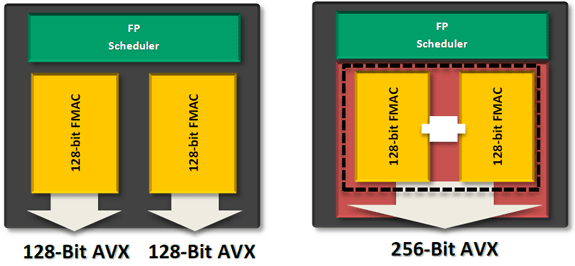
The problem is AMD had to increase the functionality of its FPU with the move to Bulldozer. The Phenom II architecture lacks SSE4 and AVX support, both of which were added in Bulldozer. Furthermore, AMD chose Bulldozer as the architecture to include support for fused multiply-add instructions (FMA). Enabling FMA support also increases the relative die area of the FPU. So while the throughput of Bulldozer's FPU hasn't increased over K8, its capabilities have. Unfortunately this means that peak FP throughput running x87/SSE2/3 workloads remains unchanged compared to the previous generation. Bulldozer will only be faster if newer SSE, AVX or FMA instructions are used, or if its clock speed is significantly higher than Phenom II.
Looking at our Cinebench 11.5 multithreaded workload we see the perfect example of this performance shuffle:
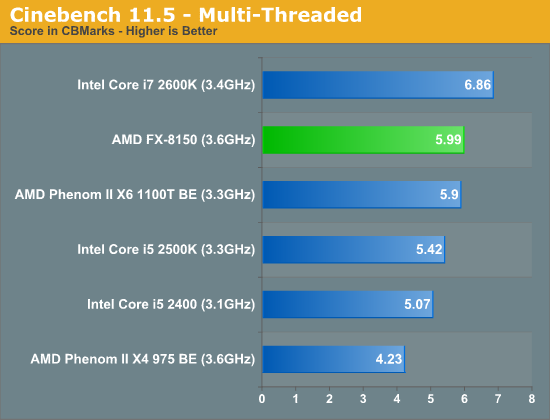
Despite a 9% higher base clock speed (more if you include turbo core), a 3.6GHz 8-core Bulldozer is only able to outperform a 3.3GHz 6-core Phenom II by less than 2%. Heavily threaded floating point workloads may not see huge gains on Bulldozer compared to their 6-core predecessors.
There's another issue. Bulldozer, at least at launch, won't have to simply outperform its quad-core predecessor. It will need to do better than a six-core Phenom II. In this comparison unfortunately, the Phenom II has the definite throughput advantage. The Phenom II X6 can execute 50% more SSE2/3 and x87 FP instructions than a Bulldozer based FX.
Since the release of the Phenom II X6, AMD's major advantage has been in heavily threaded workloads—particularly floating point workloads thanks to the sheer number of resources available per chip. Bulldozer actually takes a step back in this regard and as a result, you will see some of those same workloads perform worse, if not the same as the outgoing Phenom II X6.
Compared to Sandy Bridge, Bulldozer only has two advantages in FP performance: FMA support and higher 128-bit AVX throughput. There's very little code available today that uses AMD's FMA instruction, while the 128-bit AVX advantage is tangible.
Cache Hierarchy and Memory Subsystem
Each integer core features its own dedicated L1 data cache. The shared FP core sends loads/stores through either of the integer cores, similar to how it works in Phenom II although there are two integer cores to deal with now instead of just one. Bulldozer enables fully out-of-order loads and stores, an improvement over Phenom II putting it on parity with current Intel architectures. The L1 instruction cache is shared by the entire bulldozer module, as is the L2 cache.
The instruction cache is a large 64KB 2-way set associative cache, similar in size to the Phenom II's L1 cache but obviously shared by more "cores". A four-core Phenom II would have 256KB of total L1 I-Cache, while a four core Bulldozer will have half of that. The L1 data caches are also significantly smaller than Bulldozer's predecessor. While Phenom II offered a 64KB L1 D-Cache per core, Bulldozer only offers 16KB per integer core.
The L2 cache is much larger than what we saw in multi-core Phenom II designs however. Each Bulldozer module has a private 2MB L2 cache.
There's a single 8MB L3 cache that's shared among all Bulldozer modules on a chip. In its first incarnation, AMD has no plans to offer a desktop part without an L3 cache. However AMD indicated that the L3 cache was only really useful in server workloads and we might expect future Bulldozer derivatives (ahem, Trinity?) to forgo the L3 cache entirely as a result.

Cache accesses require more clocks in Bulldozer, due to a combination of size and AMD's desire to make Bulldozer a very high clock speed part...



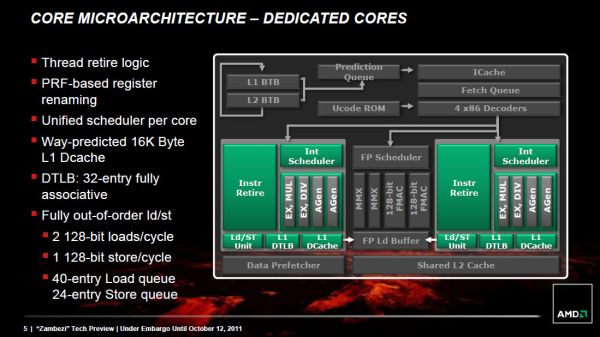
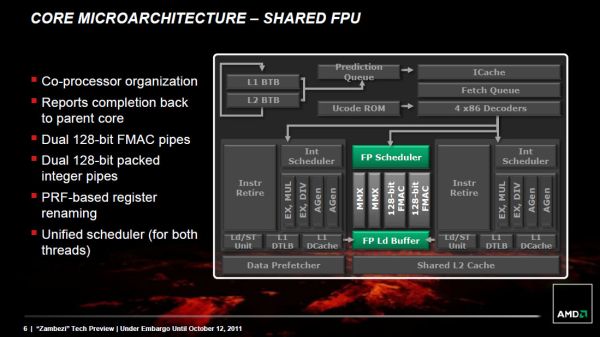
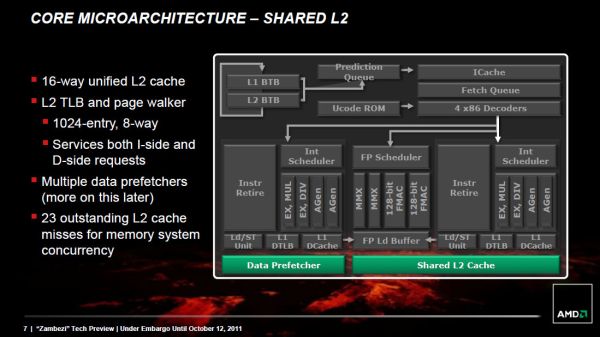








430 Comments
View All Comments
AmdInside - Wednesday, October 12, 2011 - link
Their roadmap is aggressive but when is the last time AMD has come close to meeting their schedule? Not going to happen. But do hope that they do for consumers sake.Eagle70ss - Wednesday, October 12, 2011 - link
AMD really bent over and grabbed their ankles....I'm just wondering why it took so long to release douche-dozer...I was really hoping they would have a good part this time...Will Intel stand alone as the sole quality CPU maker?? Only time will tell, but it looks to be so....silverblue - Wednesday, October 12, 2011 - link
I must say, I did expect this. That price drop wasn't exactly a giveaway, was it? Single threaded performance is generally poor and there really is something wrong with the caching. I simply refuse to believe a lack of BIOS optimisations is at fault for any of this... and blaming Windows 7 for not truly understanding Bulldozer's idiosyncracies? Come off it; Windows 8 won't even be around when Piledriver appears, and we'll have to wait to see the second generation of this particular microarchitecture performing more like it "should". Bringing back the FX moniker certainly attracted attention, however if by doing so they wanted to remind us of the fact that the FX-51 was a server CPU, they've succeeded, if only on that basis, as the FX was king of all and not just in select benchmarks as the P4 tended to be.I can't wait for Johan's server review; I just want to see if this thing really does well in its natural habitat. It's got to have a success somewhere. Thankfully, I can see far more optimism in this area. Incidentally, I was expecting Bulldozer to be able to work on eight 128-bit FP instructions per clock as opposed to 6 with Thuban, so obviously I got my wires crossed on that one.
You can't argue that Bulldozer hasn't a lot of promise, but at the same time, you can't argue that AMD haven't been trying to perform damage limitation on an already faulty product.
arjuna1 - Wednesday, October 12, 2011 - link
Nobody, and I mean, nobody at all, expected Bulldozer to reach SB like performance, obvious nobody either saw sub Phenom II performance in certain applications, but almost everything promised has been delivered, at lower prices than Intel, the way AMD has always done it, and quoting the article:"In many ways, where Bulldozer is a clear win is where AMD has always done well in: heavily threaded applications. If you're predominantly running well threaded workloads, Bulldozer will typically give you performance somewhere around or above Intel's 2500K."
PS
wolfman3k5, stop your Intel shilling, it almost look like if Intel was paying you by the hour.
wolfman3k5 - Wednesday, October 12, 2011 - link
I get $22.50 per hour from Intel plus tips. I also get a $50.00 bonus if I surpass 1000 comments / posts per day. Between 3:00AM and 7:00AM I get $25.85 per hour. I make good money writing nice things about Intel. What do you do?g101 - Wednesday, October 12, 2011 - link
What's surprising is that you apparently think that's "good money".Guess what, you little dumbshit kid, profit savvy professionals will sill be running AMD. I couldn't care less about your shitty lightly threaded games and optimized synthetic benchmarks.
Stupid children using their computers for play.
silverblue - Friday, October 14, 2011 - link
You need to bear in mind that a) AMD reintroduced the FX brand just for Zambezi, and b) JF-AMD actually started a thread entitled The Bulldozer Blog Is Live! on www.overclock.net. Regardless of whether John Freuhe is a server-focused guy or not, the point being is that he and AMD both targetted the client side in terms of i) overclockers and ii) gamers. I might be wrong, but that's how I see it. Yes, he didn't come out and say it directly that Zambezi would be a great gaming solution, but he DID say that IPC would be an improvement over their past products. Now that the reviews are out, he's nowhere to be seen, barring the odd login to do who-knows-what. Does overclock.net have any leaning towards the server market in any way?If Zambezi's poor performance is partly down to using faulty ASUS boards/anything less than 1866MHz RAM/an L1 cache bug/some weird hardware combinations/WHATEVER, I'm sure we'll find out in time, but regardless, it's going to be harming non-gaming workloads as well, so it's important to people like you as well.
silverblue - Friday, October 14, 2011 - link
Just thought I'd say that I've been a bit harsh to JF there. Out of all the AMD people who could've come along to have a chat, he was definitely the bravest. It was on his free time, and he's probably getting copious amounts of hate messages just for being an AMD rep.Proxicon - Wednesday, October 12, 2011 - link
I stayed up all night to read this review....I guess the prices on 2600k won't be going down anytime soon. I had already built my complete system in my head. Then the reviews came..
I kind of figured that if AMD was firing people and resignations were being handed in before a major launch, it wasn't going to be good. Also, no early release of benchmarks. That in itself was suspect. If they really had such a great processor than why all the secrecy. I was hoping it was an Apple play. boy, was I wrong.
You guys buy the "faildozer" and help keep the prices of the 2600K low. I'll be looking for a 2600K....
3DVagabond - Wednesday, October 12, 2011 - link
I'm not an expert, but Bulldozer seems to be a server chip pressed into desktop service. Designed for highly threaded workloads many consumer tasks just aren't it's forte (and also designed to have even more cores than 8). While it isn't competitive in single thread performance, if you use highly threaded workloads enough and aren't afraid to O/C to boost the single core performance, Bulldozer can be the better chip. That is if the price is right. The 8120 might be an awesome value in this scenario. We'll have to wait for reviews to be sure.One question, please. When you O/C'd the 8150, did you only use stock cooling? From the review it sounded like you did, but instead of saying so clearly, you said it wouldn't do 5GHz on "air" (I believe that was the statement? Feel free to flame me if I'm wrong. :D). So, to be clear, would it not do 5GHz on air with a top notch cooler, or did you only try the stock cooler?
Thanks.